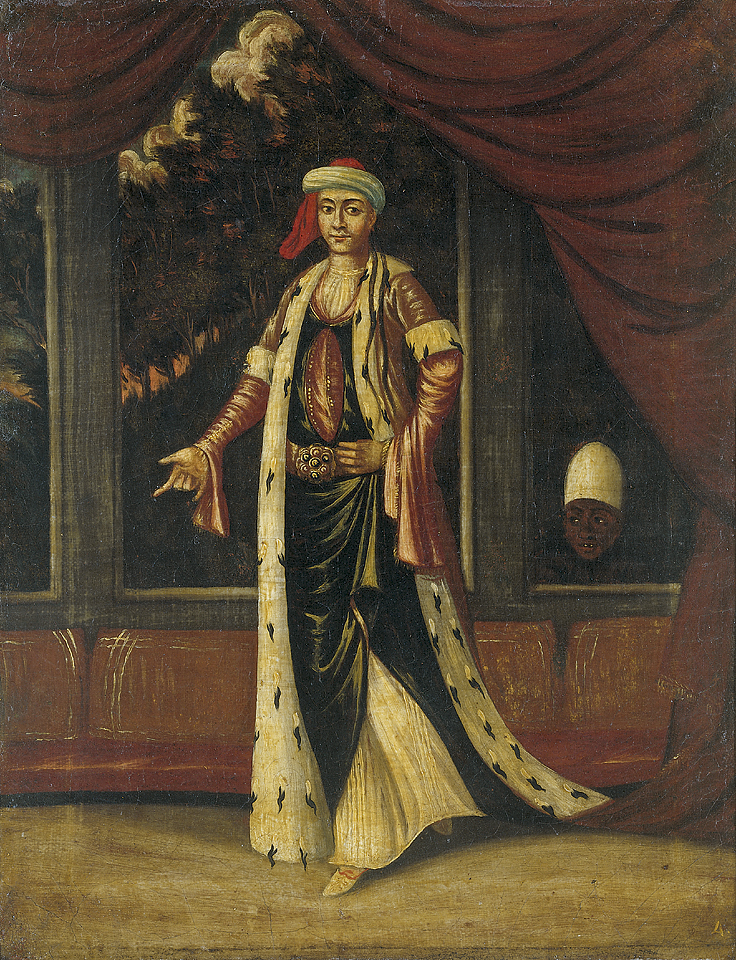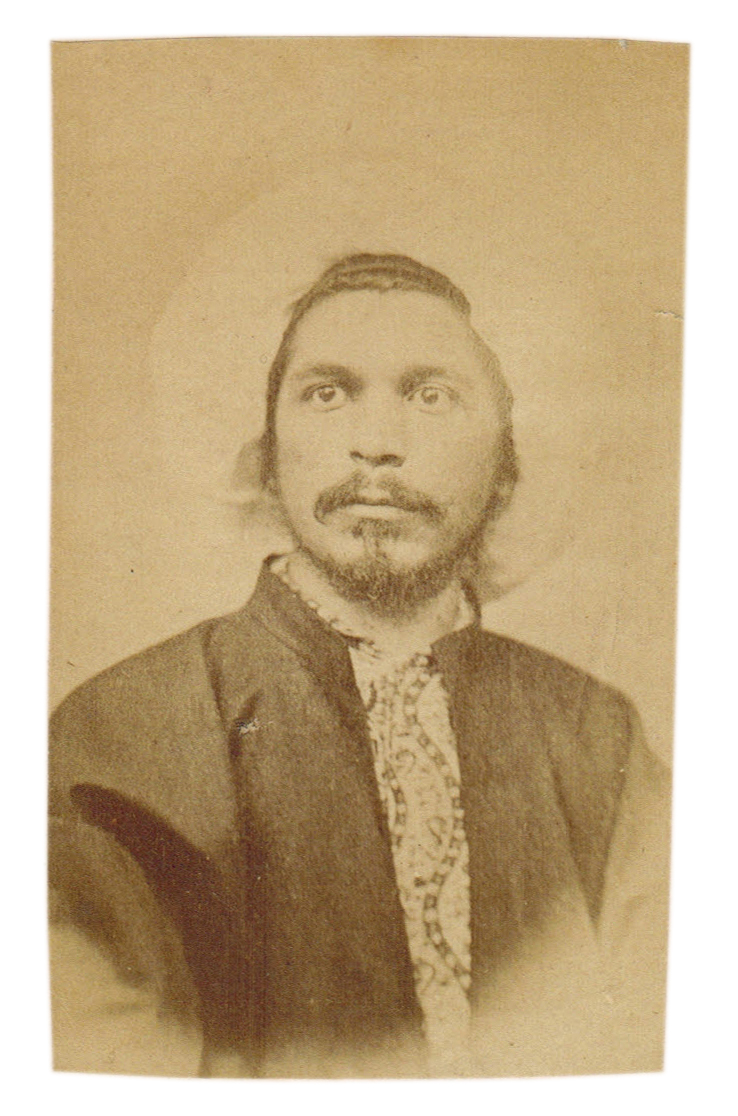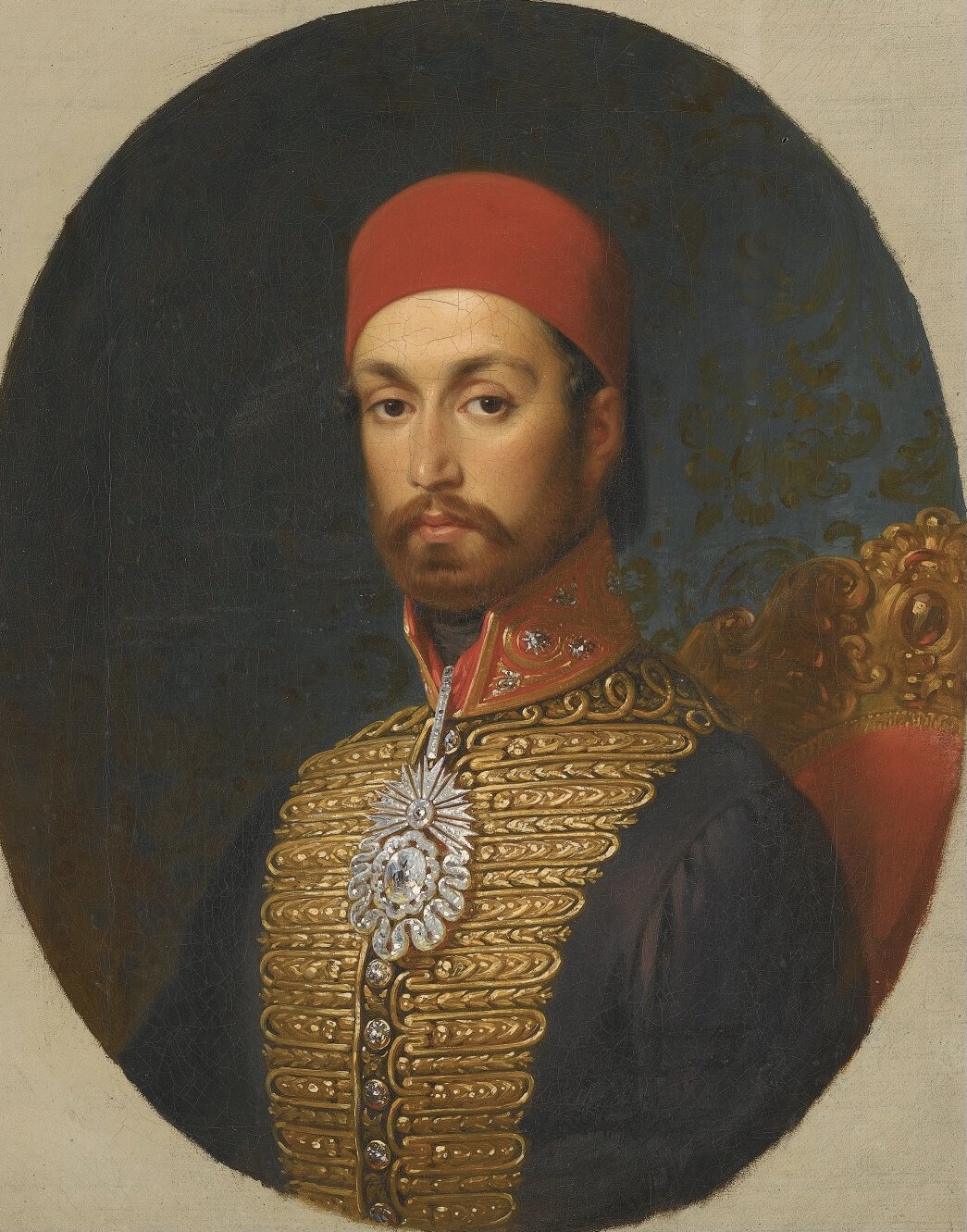|
Еһevkefza Sultan
Еһevkefza Sultan (; ka, бғЁбғ”бғ•бғҷбғҗбғӨбғ–бғҗ бғЎбғЈбғҡбғ—бғҗбғңбғҳ; 12 December 1820 - 17 September 1889; meaning "one who cheers up" in Persian), also known as Еһevkefza KadДұn, was a consort of Sultan Abdulmejid I of the Ottoman Empire. She held the position of Valide Sultan from 30 May 1876 to 31 August 1876, when her son Еһehzade Murad ascended the throne as Murad V. Early life Of Mingrelian and Circassian origin, Еһevkefza KadДұn was born on 12 December 1820 and she was presented at the age of seven during the reign of Sultan Mahmud II, by the first imam, Zeynelabidin Efendi. She served the Sultan for seven or eight years as a dancer in his presence. She was then attached to the entourage of Nurtab KadДұn, one of Sultan's consorts. She has been described as a woman of extraordinary beauty, of medium height, curvy, with black eyes and hair, and very kindly, but not very intelligent, easy to influence and devoid of cunning. AbdГјlmejid fell in love with her beauty and m ... [...More Info...] [...Related Items...] OR: [Wikipedia] [Google] [Baidu] [Amazon] |
Valide Sultan
Valide Sultan (, lit. "Sultana mother") was the title held by the mother of a ruling sultan of the Ottoman Empire. The Ottomans first formally used the title in the 16th century as an epithet of Hafsa Sultan (died 1534), mother of Sultan Suleiman the Magnificent , Suleyman I (), superseding the previous epithets of Valide Hatun (lady mother), ''Mahd-i Ulya (other), mehd-i ulya'' ("cradle of the great"). or "the nacre of the pearl of the sultanate".Leslie Peirce, Peirce, Leslie P., ''The Imperial Harem: Women and Sovereignty in the Ottoman Empire'', Oxford University Press, 1993, (paperback) Normally, the living mother of a reigning sultan held this title. Those mothers who died before their sons' accession to the throne never received the title of . In special cases sisters, grandmothers and stepmothers of a reigning sultan assumed the title and/or the functions . Term The word () literally means 'mother' in Ottoman Turkish, from Arabic . The Turkish phonology, Tu ... [...More Info...] [...Related Items...] OR: [Wikipedia] [Google] [Baidu] [Amazon] |
Mahmud II
Mahmud II (, ; 20 July 1785 вҖ“ 1 July 1839) was the sultan of the Ottoman Empire from 1808 until his death in 1839. Often described as the "Peter the Great of Turkey", Mahmud instituted extensive administrative, military, and fiscal reforms. His disbandment of the conservative Janissary, Janissary Corps removed a major obstacle to his and his successors' reforms in the Empire, creating the foundations of the subsequent Tanzimat era. Mahmud's reign was also marked by further Ottoman military defeats and loss of territory as a result of nationalist uprisings and European intervention. Mahmud ascended the throne following an Ottoman coups of 1807вҖ“1808, 1808 coup that deposed his half-brother Mustafa IV. Early in his reign, the Ottoman Empire ceded Bessarabia to Russia at the end of the Russo-Turkish War (1806вҖ“1812), 1806вҖ“1812 Russo-Turkish War. Greece waged a Greek War of Independence, successful war of independence that started in 1821 with British, French and Russian su ... [...More Info...] [...Related Items...] OR: [Wikipedia] [Google] [Baidu] [Amazon] |
List Of Mothers Of The Ottoman Sultans
This is a list of the biological mothers of Ottoman sultans. There were thirty-six sultans of the Ottoman Empire in twenty-one generations (during early days the title ''Bey'' or ''Ghazi'' was used instead of ''Sultan''). Throughout the six-century history the sultans were the members of the same house, namely the House of Osman ( Turkish: ''OsmanlДұ HanedanДұ''). Mothers of the Ottoman Sultans This list is distinct from the list of Valide Sultans of the Ottoman Empire. Valide Sultan was the title of the mother of the reigning sultan. The mothers who died before their sons' accession to throne, never assumed the title of Valide Sultan like HГјrrem, Muazzez, MihriЕҹah, and Еһermi. On the other hand, step mothers who were not the biological mothers but raised the princes whose mothers had died assumed the title of Valide Sultan like Perestu. So there were Valide Sultans who were not the mothers, and there were mothers who were not the Valide Sultans. The detailed list of t ... [...More Info...] [...Related Items...] OR: [Wikipedia] [Google] [Baidu] [Amazon] |
List Of Consorts Of The Ottoman Sultans
This is a list of consorts of the Ottoman sultans, the wives and concubines of the monarchs of the Ottoman Empire who ruled over the transcontinental empire from its inception in 1299 to its dissolution in 1922. Honorific and titles Hatun Hatun () was used as an honorific for women in the Ottoman Empire, Ottoman period, roughly equivalent to the English term ''Lady''. The term was being used for the Ottoman sultan's consorts. When the son of one of the consorts ascended the throne she became ''Valide Hatun'' (Mother of Sultan). Sultan Sultan (ШіЩ„Ш·Ш§ЩҶ) is a word of Arabic origin, originally meaning "authority" or "dominion". By the beginning of the 16th century, the title of sultan, carried by both men and women of the Ottoman dynasty, was replacing other titles by which prominent members of the imperial family had been known (notably ''hatun'' for women and ''bey'' for men), with imperial women carrying the title of "Sultan" after their given names. Consequently, the tit ... [...More Info...] [...Related Items...] OR: [Wikipedia] [Google] [Baidu] [Amazon] |
KadДұn (title)
KadДұn () was the title given to the imperial consort of the Sultan of the Ottoman Empire towards the beginning of the seventeenth century. The title came into official usage at the end of the century, and remained in usage until the nineteenth and twentieth centuries. Ranks and titles A was a titled consort, and recognised as such by the Sultan. The sultans usually had four s, although they might have more over a lifetime, because from time to time, one would die or be retired to the Old Palace, or were divorced. They were ranked as (senior , senior consort), (second , second consort), (third , third consort), (fourth , fourth consort), and so on, in order of their elevation to that position. The s usually held the prefix titles of ('illustrious', 'highness'), ('the virtuous'), ('honest', 'virtuous'), ('prosperous', 'felicitous'), and ('gracious'), and the suffix titles of ('her ladyship'), and ('highness'). Status and promotion The s were chosen from among the s. The ... [...More Info...] [...Related Items...] OR: [Wikipedia] [Google] [Baidu] [Amazon] |
AyЕҹegГјl Siray
AyЕҹegГјl is a Turkish given name for females. The name is derived from "AyЕҹe", the Turkish form for the Arabic name Aisha, meaning "she who lives," plus "GГјl," a Persian word meaning rose." Notable women named AyЕҹegГјl include: *AyЕҹegГјl Abadan (born 1980), Turkish pianist * (born 1968), TurkishвҖ“German writer * AyЕҹegГјl AldinГ§ (born 1957), Turkish singer and actress * AyЕҹegГјl Behlivan (born 1989), Turkish Muay Thai and wushu practitioner. * AyЕҹegГјl ГҮoban (born 1992), Turkish weightlifter * AyЕҹegГјl Ergin (born 1971), Turkish Taekwondo practitioner * AyЕҹegГјl GГјnay (born 1992), Turkish basketball player *AyЕҹegГјl Pehlivanlar AyЕҹegГјl Pehlivanlar (born 5 December 1979) is a Turkish Paralympic shooting, paralympic shooter competing in the Paralympic shooting#Pistol Events, pistol events. She won a bronze medal at the 2016 Summer Paralympics in Rio de Janeiro. Early ... (born 1979), Turkish Paralympic sport shooter Other use * , Liberia-flagged Turkish powersh ... [...More Info...] [...Related Items...] OR: [Wikipedia] [Google] [Baidu] [Amazon] |
HДұfzДұ Topuz
HДұfzДұ Topuz (25 January 1923 вҖ“ 26 September 2023) was a Turkish journalist, travel writer and novelist. He also served as a lecturer on journalism at several universities. Early life Topuz was born on 25 January 1923 in Istanbul. After finishing his secondary education at the Galatasaray High School in 1942, he studied law at Istanbul University, graduating in 1948. Later, he went to France, where he attended University of Strasbourg to conduct further studies in international law and journalism between 1957 and 1959. In 1960, he earned a doctoral degree in journalism from the same university. Professional career After graduating from Istanbul University, Topuz entered journalism, and was employed between 1948 and 1957 at the daily newspaper ''AkЕҹam'', where he worked as a reporter and later as an editor. He co-founded Istanbul Journalists' Union, and served as its leader. During his time in France, he applied for a vacant post at the headquarters of UNESCO in Paris. He wo ... [...More Info...] [...Related Items...] OR: [Wikipedia] [Google] [Baidu] [Amazon] |
New Mosque, Istanbul
The New Mosque (, , originally named the Valide Sultan Mosque, ) and later New Valide Sultan Mosque () after its partial reconstruction and completion between 1660 and 1665, is an Ottoman imperial mosque located in the EminГ¶nГј quarter of Istanbul, Turkey. It is situated on the Golden Horn, at the southern end of the Galata Bridge, and is a notable Istanbul landmark marking the crossing from the old historic core of the city to the BeyoДҹlu (Pera) district. The mosque is a notable example of the Sultanate of Women period in Ottoman Empire. History Valide Sultan Mosque The construction of the mosque began in 1597. It was ordered by Safiye Sultan, who was the wife of Sultan Murad III and later Valide Sultan (Queen Mother) of Sultan Mehmed III. She ordered the mosque in her capacity as ''Valide Sultan'', two years after Mehmed III's ascension to the Ottoman throne in 1595, hence the original formal name "Valide Sultan Mosque". The original architect was Davut AДҹa, an appren ... [...More Info...] [...Related Items...] OR: [Wikipedia] [Google] [Baidu] [Amazon] |
Ali Suavi
Ali Suavi (; 8 December 1839 вҖ“ 20 May 1878) was an Ottoman Turks, Ottoman Turk political activist, journalist, educator, theologian and reformer. He was exiled to Kastamonu because of his writings against List of sultans of the Ottoman Empire, Ottoman Sultan AbdГјlaziz. He is one of the first Pan-Turkism, Pan-Turkists in the Ottoman period. Biography He taught at an elementary school in Bursa, preached at the Sehzade Mosque in Ottoman Constantinople, Constantinople (now Istanbul), wrote for Filip (Philip) EfendiвҖҷs newspaper ''Muhbir'', and worked in different positions at offices in Simav, Plovdiv, and Sofia. He was a member of the Young Ottomans and editor of its official journal. He was also one of the contributors of pan-Islamist newspaper ''Basiret''. In 1867 he escaped prosecution by fleeing to Paris along with fellow Young Ottomans NamДұk Kemal and Ziya Pasha, where he stayed until AbdГјlaziz was dethroned in 1876. With his background in journalism, Suavi was placed ... [...More Info...] [...Related Items...] OR: [Wikipedia] [Google] [Baidu] [Amazon] |
Dolmabahçe Palace
DolmabahГ§e Palace ( ) is a 19th-century imperial palace located in Istanbul, Turkey, along the European shore of the Bosporus, which served as the main administrative center of the Ottoman Empire from 1856 to 1887 and from 1909 to 1922. History DolmabahГ§e Palace was ordered by the empire's 31st sultan, AbdГјlmecid I, and built between the years 1843 and 1856. Previously, the sultan and his family had lived at the TopkapДұ Palace, but as the medieval TopkapДұ was lacking in contemporary style, luxury, and comfort, as compared to the palaces of the European monarchs, AbdГјlmecid decided to build a new modern palace near the site of the former BeЕҹiktaЕҹ Sahil Palace, which was demolished. HacДұ Said AДҹa was responsible for the construction works, while the project was realized by architects Garabet Balyan, his son NigoДҹayos Balyan and Evanis Kalfa (members of the Armenian Balyan family of Ottoman court architects). , the construction cost the equivalent of ca. US$3 bill ... [...More Info...] [...Related Items...] OR: [Wikipedia] [Google] [Baidu] [Amazon] |
Valide Sultan
Valide Sultan (, lit. "Sultana mother") was the title held by the mother of a ruling sultan of the Ottoman Empire. The Ottomans first formally used the title in the 16th century as an epithet of Hafsa Sultan (died 1534), mother of Sultan Suleiman the Magnificent , Suleyman I (), superseding the previous epithets of Valide Hatun (lady mother), ''Mahd-i Ulya (other), mehd-i ulya'' ("cradle of the great"). or "the nacre of the pearl of the sultanate".Leslie Peirce, Peirce, Leslie P., ''The Imperial Harem: Women and Sovereignty in the Ottoman Empire'', Oxford University Press, 1993, (paperback) Normally, the living mother of a reigning sultan held this title. Those mothers who died before their sons' accession to the throne never received the title of . In special cases sisters, grandmothers and stepmothers of a reigning sultan assumed the title and/or the functions . Term The word () literally means 'mother' in Ottoman Turkish, from Arabic . The Turkish phonology, Tu ... [...More Info...] [...Related Items...] OR: [Wikipedia] [Google] [Baidu] [Amazon] |
Servetseza KadДұn
Servetseza KadДұn (; 1823 вҖ“ 24 September 1878; meaning "Worthy of riches" in Persian) was the first consort and chief consort ( BaЕҹKadin) of Sultan Abdulmejid I of the Ottoman Empire. Early life Of Circassian and Georgian origin, Servetseza KadДұn belonged to the Temruko princely family. She was daughter of Prince Mansur Bey Temruko and one of his consorts, a Georgian Princess of DadeЕҹkeliani family. Servetseza bornname is unknown. She was born on 1823 in Maykop, Adyghe Republic's capital. She had been educated on the household of Esma Sultan, daughter of Sultan Abdul Hamid I, who give her the name Servetseza. Marriage When Abdulmejid ascended the throne, after the death of his father on 2 July 1839, BezmiГўlem Sultan, selected her as a consort for her son, the new Sultan, because Servetseza was half georgiana as Valide Sultan herself. The marriage took place in 1839, and Servetseza became his principal consort with the title of "BaЕҹKadin" directly after the wedding, a pos ... [...More Info...] [...Related Items...] OR: [Wikipedia] [Google] [Baidu] [Amazon] |






